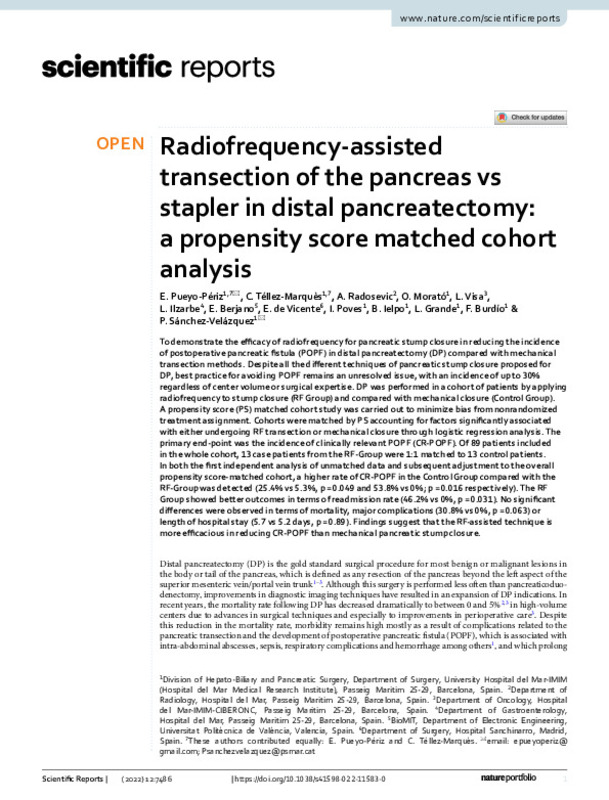Kleeff, J. et al. Distal pancreatectomy: Risk factors for surgical failure in 302 consecutive cases. Ann. Surg. 245(4), 573–582 (2007).
De Rooij, T. et al. Minimally invasive versus open distal pancreatectomy (LEOPARD): A multicenter patient-blinded randomized controlled trial. Ann. Surg. 269(1), 2–9 (2019).
Knaebel, H. P., Diener, M. K., Wente, M. N., Büchler, M. W. & Seiler, C. M. Systematic review and meta-analysis of technique for closure of the pancreatic remnant after distal pancreatectomy. Br. J. Surg. 92(5), 539–546 (2005).
[+]
Kleeff, J. et al. Distal pancreatectomy: Risk factors for surgical failure in 302 consecutive cases. Ann. Surg. 245(4), 573–582 (2007).
De Rooij, T. et al. Minimally invasive versus open distal pancreatectomy (LEOPARD): A multicenter patient-blinded randomized controlled trial. Ann. Surg. 269(1), 2–9 (2019).
Knaebel, H. P., Diener, M. K., Wente, M. N., Büchler, M. W. & Seiler, C. M. Systematic review and meta-analysis of technique for closure of the pancreatic remnant after distal pancreatectomy. Br. J. Surg. 92(5), 539–546 (2005).
Rodríguez, J. R. et al. Implications and cost of pancreatic leak following distal pancreatic resection. Arch. Surg. 141(4), 361–366 (2006).
Diener, M. K. et al. Efficacy of stapler versus hand-sewn closure after distal pancreatectomy (DISPACT): A randomised, controlled multicentre trial. Lancet 377(9776), 1514–1522 (2011).
Montorsi, M. et al. Efficacy of an absorbable fibrin sealant patch (TachoSil) after distal pancreatectomy: A multicenter, randomized, controlled trial. Ann. Surg. 256(5), 853–860 (2012).
Suc, B. et al. Temporary fibrin glue occlusion of the main pancreatic duct in the prevention of intra-abdominal complications after pancreatic resection: Prospective randomized trial. Ann. Surg. 237(1), 57–65 (2003).
Bassi, C. et al. The 2016 update of the International Study Group (ISGPS) definition and grading of postoperative pancreatic fistula: 11 years after. Surgery 161(3), 584–591 (2017).
Maggino, L., Malleo, G., Salvia, R., Bassi, C. & Vollmer, C. M. Defining the practice of distal pancreatectomy around the world. HPB 21(10), 1277–1287 (2019).
McCormack, L., Petrowsky, H. & Clavien, P. A. Novel approach using dissecting sealer for uncinate process resection during pancreaticoduodenectomy. J. Am. Coll. Surg. 202(3), 556–558 (2006).
Ganguli, S. & Goldberg, S. N. Radiofrequency equipment and scientific basis for radiofrequency ablation. Interv. Radiol. Treat. Liver Tumors https://doi.org/10.1017/CBO9780511575433.011 (2008).
Zervas, N. T. & Kuwayama, A. Pathological characteristics of experimental thermal lesions. Comparison of induction heating and radiofrequency electrocoagulation. J. Neurosurg. 37(4), 418–422 (1972).
Goldberg, S. N., Gazelle, G. S., Compton, C. C., Mueller, P. R. & Tanabe, K. K. Treatment of intrahepatic malignancy with radiofrequency ablation: Radiologic–pathologic correlation. Cancer 88(11), 2452–2463 (2000).
Nagakawa, Y. et al. The VIO soft-coagulation system can prevent pancreatic fistula following pancreatectomy. J. Hepatobiliary Pancreat. Surg. 15(4), 359–365 (2008).
Blansfield, J. A. et al. Novel method of stump closure for distal pancreatectomy with a 75% reduction in pancreatic fistula rate. J. Gastrointest. Surg. 16(3), 524–528 (2012).
Fronza, J. S., Bentrem, D. J., Baker, M. S., Talamonti, M. S. & Ujiki, M. B. Laparoscopic distal pancreatectomy using radiofrequency energy. Am. J. Surg. 199(3), 401–404 (2010).
Dorcaratto, D. et al. Radiofrequency is a secure and effective method for pancreatic transection in laparoscopic distal pancreatectomy: Results of a randomized, controlled trial in an experimental model. Surg. Endosc. 27(10), 3710–3719 (2013).
Quesada, R. et al. Impact of monopolar radiofrequency coagulation on intraoperative blood loss during liver resection: A prospective randomised controlled trial. Int. J. Hyperth. 33(2), 135–141 (2017).
Ceppa, E. P. et al. Does pancreatic stump closure method influence distal pancreatectomy outcomes?. J. Gastrointest. Surg. 19(8), 1449–1456 (2015).
Dorcaratto, D. et al. Laparoscopic distal pancreatectomy: Feasibility study of radiofrequency-assisted transection in a porcine model. J. Laparoendosc. Adv. Surg. Tech. 22(3), 242–248 (2012).
Burdío, F. et al. Radiofrequency-induced heating versus mechanical stapler for pancreatic stump closure: In vivo comparative study. Int. J. Hyperth. 32(3), 272–280 (2016).
Dindo, D., Demartines, N. & Clavien, P.-A. Classification of surgical complications. Ann. Surg. 240(2), 205–213 (2004).
Slankamenac, K., Graf, R., Barkun, J., Puhan, M. A. & Clavien, P. A. The comprehensive complication index: A novel continuous scale to measure surgical morbidity. Ann. Surg. 258(1), 1–7 (2013).
Lonjon, G., Porcher, R., Ergina, P., Fouet, M. & Boutron, I. Potential pitfalls of reporting and bias in observational studies with propensity score analysis assessing a surgical procedure: A methodological systematic review. Ann. Surg. 265(5), 901–909 (2017).
Burdo, F. et al. A new single-instrument technique for parenchyma division and hemostasis in liver resection: A clinical feasibility study. Am. J. Surg. 200(6), e75–e80 (2010).
Jimenez, R. E. & Hawkins, W. G. Emerging strategies to prevent the development of pancreatic fistula after distal pancreatectomy. Surgery (United States) 152(3 Suppl.), S64–S70 (2012).
[-]









